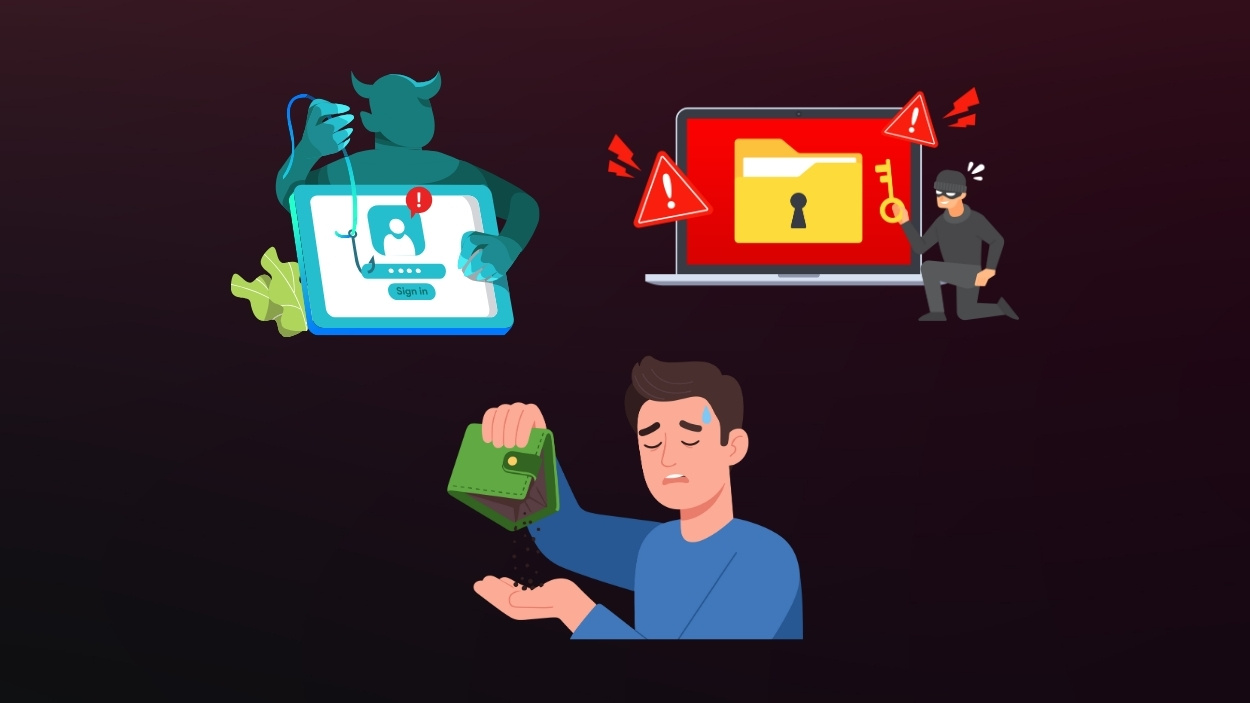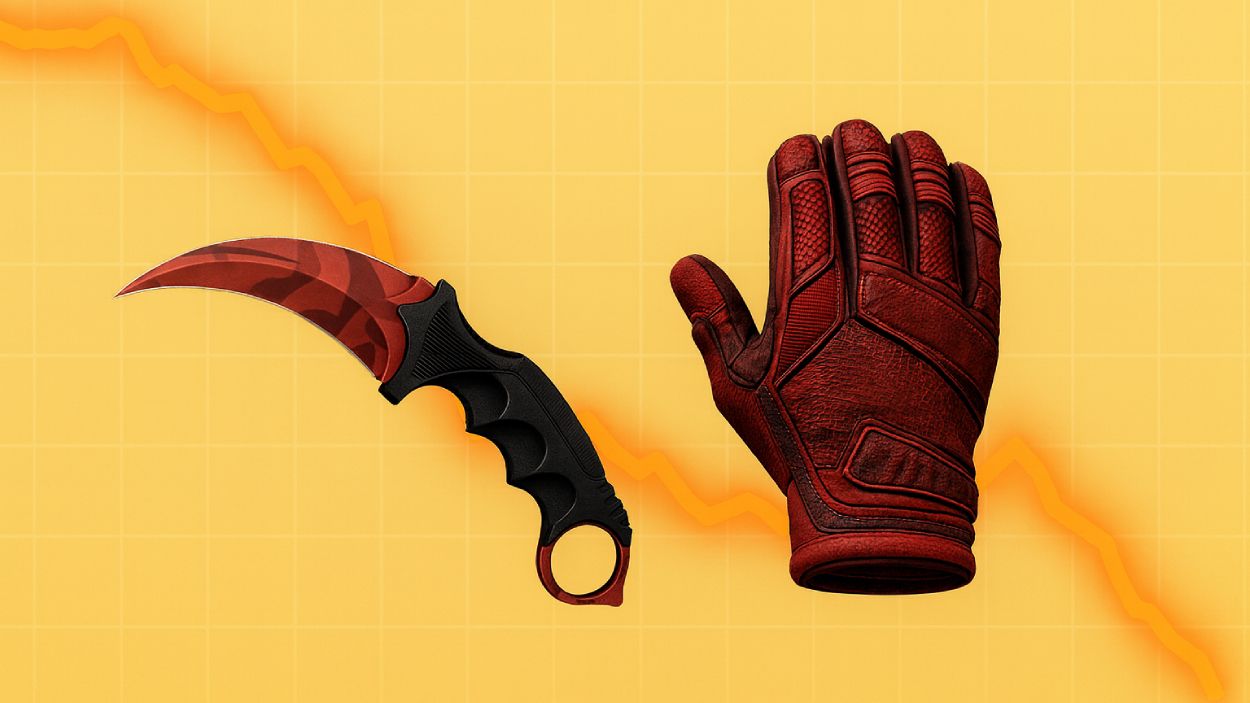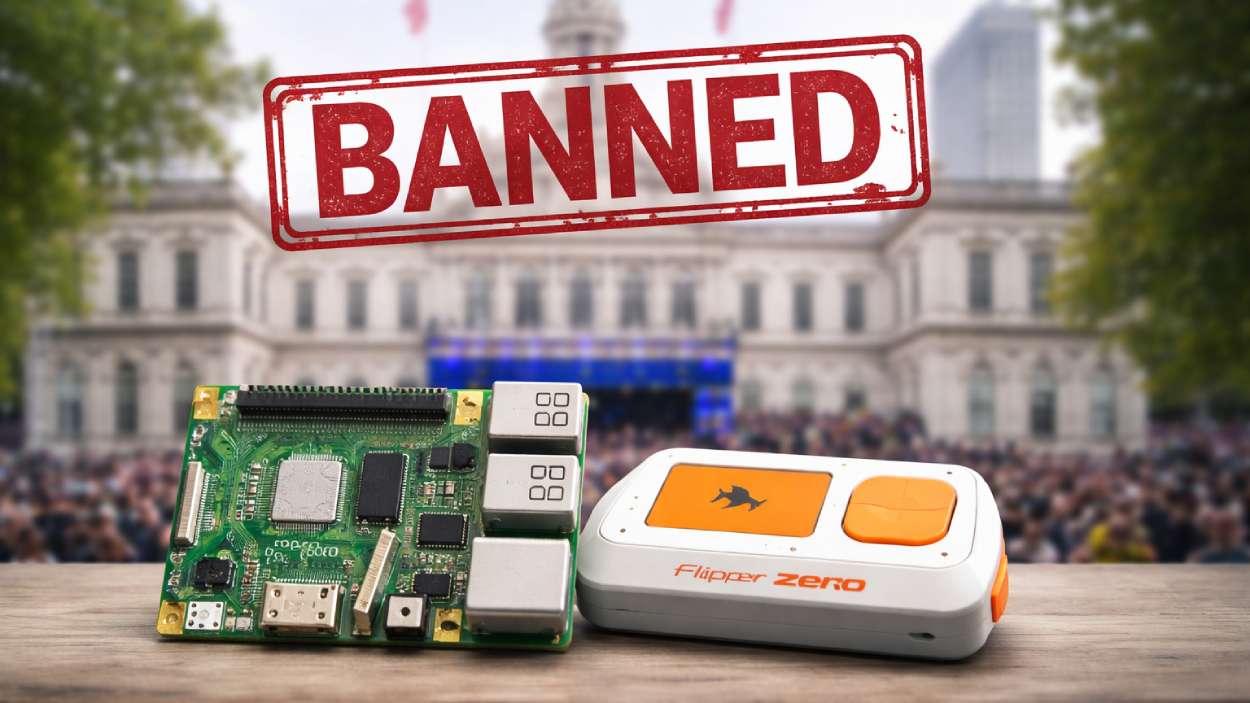In 2007, Megan Meier’s tragic story shocked the world, a 13-year-old girl who took her own life after being cyberbullied on MySpace. Fast forward to 2025, and digital harassment has become even more pervasive. While technology continues to connect people across the globe, it also provides a dark alley for anonymous attacks. From classrooms to boardrooms, cyberbullying is no longer a rare occurrence; it’s a modern epidemic shaping how people interact, feel, and cope in a digital-first society.
This article unpacks the most recent 2025 cyberbullying statistics, shedding light on who it affects, how it manifests, and what can be done to counteract it.
Editor’s Choice
- 36% of teenagers in the U.S. reported being victims of cyberbullying in 2025.
- 42% of LGBTQ+ youth faced digital harassment in 2025, making them the most targeted identity group online.
- 18% of adults aged 30-49 in the U.S. experienced cyberbullying in 2025.
- 54% of female internet users under 25 said they received threatening or explicit messages in 2025.
- 67% of social media users believe platforms are not doing enough to combat cyberbullying in 2025.
- 28% of cyberbullying incidents in 2025 resulted in victims deleting or deactivating their social media accounts.
- 62% of parents in the U.S. expressed concern about their children being bullied online in 2025.
Cyberbullying Rates Across Social Media Platforms
- Instagram ranks highest for reported cyberbullying, with 29.8% of incidents occurring on the platform.
- Facebook follows closely, accounting for 26.2% of cyberbullying cases among social media users.
- Snapchat is third, with 22% of users experiencing bullying behaviors on the app.
- WhatsApp sees 8.5% of cyberbullying reports, showing concerns even on messaging-based platforms.
- YouTube accounts for 7.1% of cyberbullying activity, despite being a content-focused platform.
- Twitter registers the lowest percentage in this dataset, with 6.4% of users reporting bullying issues.
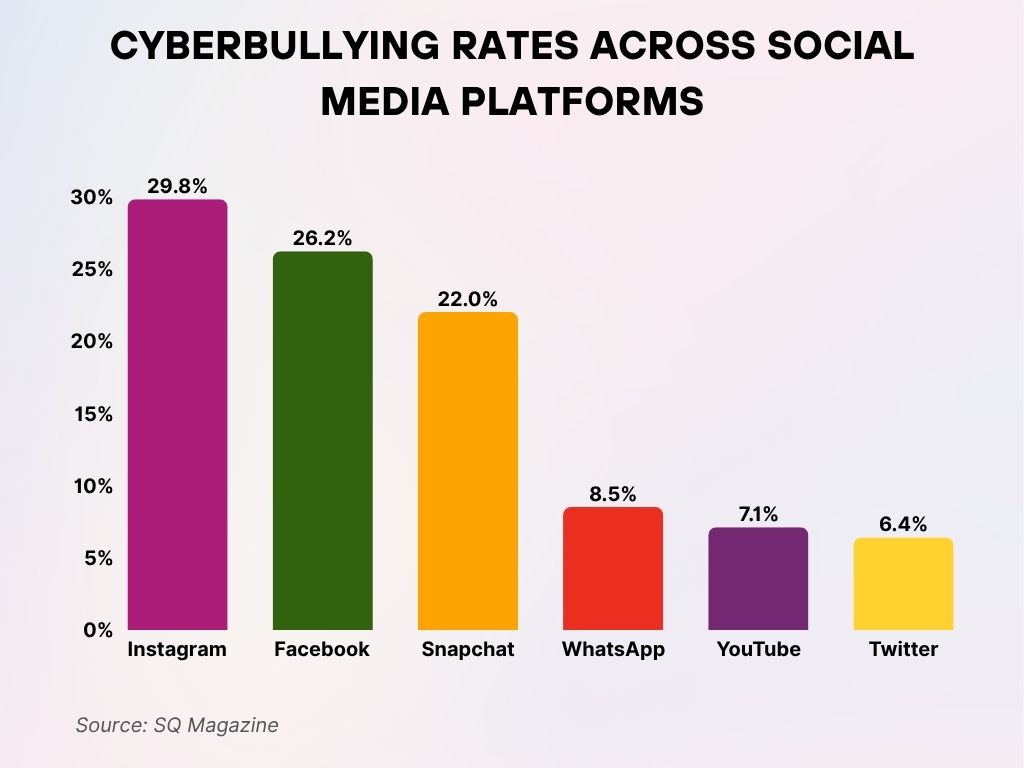
Global Prevalence of Cyberbullying
- 22% of global internet users aged 12 to 17 have experienced cyberbullying in 2025.
- In India, 37% of teens said they were bullied online in 2025, marking one of the highest rates globally.
- 31% of students in Europe reported at least one instance of online harassment during the 2024–2025 academic year.
- 15% of Japanese students encountered persistent cyberbullying in 2025, often via private messaging apps.
- In Brazil, 41% of adolescents claimed to have witnessed cyberbullying in group chats during 2025.
- 39% of Canadian youth say they’ve experienced or observed online hate speech in 2025.
- 17% of middle school students globally said they’ve been excluded from online activities as a form of bullying in 2025.
- 26% of cyberbullying victims in Australia reported their harassment occurred through gaming platforms in 2025.
- 11% of surveyed teenagers in South Korea admitted to having bullied others online in 2025.
- 34% of online harassment cases reported globally were linked to anonymous accounts in 2025.
Cyberbullying by Age Group
- 36% of 13–17-year-olds in the U.S. experienced cyberbullying in 2025, making this the highest-risk age group.
- 29% of preteens (ages 9–12) reported online harassment in 2025.
- Among young adults aged 18–24, 24% were targets of online bullying in 2025.
- 18% of children under 10 were exposed to digital harassment or threats in 2025, largely on video-sharing platforms.
- For adults aged 25–34, 14% reported workplace-related cyberbullying in 2025.
- 7% of seniors (65+) faced some form of online fraud or impersonation with malicious intent in 2025.
- 39% of college students said they had received unwanted messages or threats via social media in 2025.
- 21% of high school students stated they had been the subject of online rumors or doxxing in 2025.
- 12% of elementary school students experienced name-calling or teasing through class chat apps in 2025.
- 25% of e-learning students across all age groups were subjected to online bullying during virtual sessions in 2025.
Cyberbullying Among LGBT Youth
- 35% of cyberbullied LGBT youth have received online threats, highlighting the severity of digital harassment.
- 58% of cyberbullied LGBT individuals have experienced hate speech at least once.
The data underscores how discrimination online parallels real-world targeting, especially among vulnerable groups like LGBT teens.
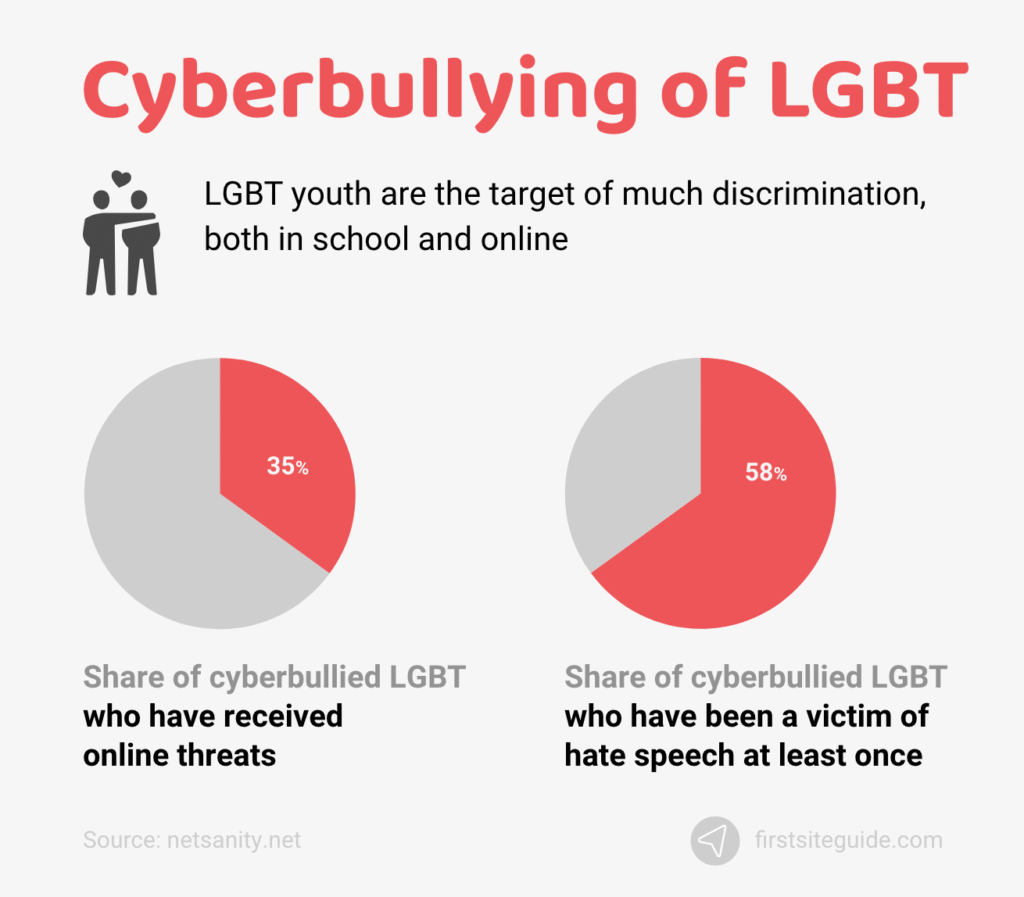
Gender Differences in Cyberbullying Incidents
- 54% of female teens reported experiencing online harassment in 2025, compared to 36% of male teens.
- 43% of non-binary youth said they were targets of repeated cyberbullying in 2025.
- 28% of boys aged 10–14 admitted to participating in cyberbullying in 2025.
- 61% of female respondents noted being harassed based on appearance or body image in 2025.
- 19% of males were cyberbullied through online gaming voice chats in 2025.
- 46% of transgender youth experienced misgendering and hate speech online in 2025.
- 32% of girls reported being threatened with the release of private images (sextortion) in 2025.
- 23% of males aged 15–19 said they were bullied due to sports performance or competitiveness online in 2025.
- 17% of females in coeducational schools reported group bullying via private Instagram accounts in 2025.
- 12% of boys in single-gender schools experienced bullying in group gaming environments in 2025.
Psychological and Social Impact
- 38% of cyberbullying victims in 2025 reported symptoms of depression, including prolonged sadness and withdrawal.
- 22% of teen victims in 2025 admitted to having suicidal thoughts following online harassment.
- 17% of students who were cyberbullied in 2025 developed anxiety-related disorders such as panic attacks or social phobia.
- 41% of young victims in 2025 reported a significant drop in self-esteem and confidence.
- 26% of bullied teens said they avoided school or group events due to online threats in 2025.
- 19% of adolescents who experienced cyberbullying developed disordered eating patterns in 2025.
- 45% of parents noticed behavioral changes like aggression or isolation in children who faced digital harassment in 2025.
- 12% of victims aged 12–16 began self-harming in response to ongoing online bullying in 2025.
- 24% of high school students reported feelings of paranoia or being constantly watched online in 2025.
- 29% of college-age victims said they lost close friendships due to cyberbullying incidents in 2025.
Emotional and Behavioral Impact of Cyberbullying
- 41% of individuals who faced cyberbullying developed social anxiety, severely affecting their interactions and confidence.
- 37% reported developing depression, highlighting the deep emotional toll of online harassment.
- 26% experienced suicidal thoughts, a devastating consequence that underscores the urgency of intervention.
- 26% chose to delete their social media profiles to escape bullying.
- 25% admitted to self-harming, reflecting the internalized trauma caused by persistent abuse.
- 25% decided to stop using social media altogether for mental health reasons.
- 20% skipped class, showing how cyberbullying can disrupt educational engagement.
- 14% developed an eating disorder, linking emotional distress with physical health challenges.
- 9% turned to drug or alcohol abuse, emphasizing long-term behavioral risks.
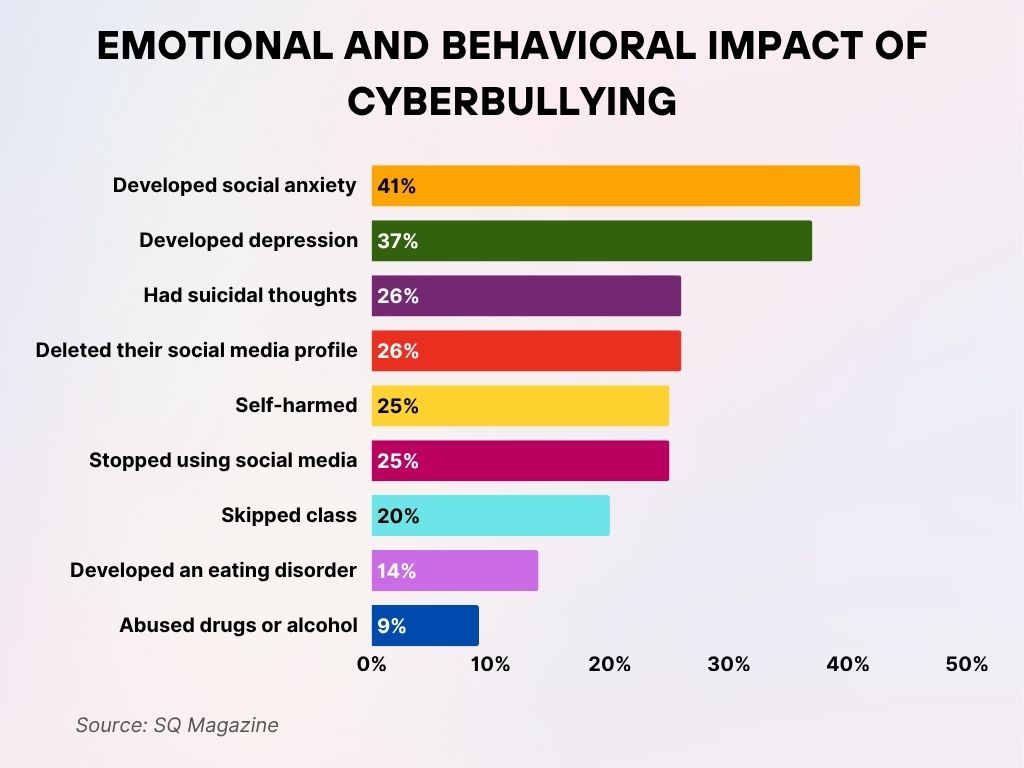
Cyberbullying in Schools and Educational Settings
- 61% of middle and high schools in the U.S. reported at least one cyberbullying incident during 2025.
- 39% of school administrators identified group chat apps as the most common venue for cyberbullying in 2025.
- 33% of students aged 11–18 stated they were bullied by classmates outside school hours, online in 2025.
- 48% of educators in 2025 said they felt unprepared to handle digital harassment cases effectively.
- 22% of schools introduced formal digital citizenship training in their curriculum in 2025.
- 37% of cyberbullying cases in schools led to disciplinary action such as suspension or expulsion in 2025.
- 16% of students said they were bullied during virtual learning sessions in 2025.
- 14% of elementary school teachers reported receiving complaints from parents about online bullying in 2025.
- 26% of high schools implemented anonymous reporting systems for cyberbullying in 2025.
- 35% of students said they witnessed peers being cyberbullied but chose not to intervene in 2025.
Workplace Cyberbullying Trends
- 18% of remote workers in the U.S. experienced workplace-related digital harassment in 2025.
- 23% of employees aged 25–39 reported receiving threatening or harassing emails from coworkers in 2025.
- 14% of victims of workplace cyberbullying took medical leave for mental health reasons in 2025.
- 31% of female employees said they were targeted with sexist or inappropriate comments via internal messaging platforms in 2025.
- 12% of HR departments handled at least one cyberbullying complaint during the first half of 2025.
- 40% of incidents in professional settings involved anonymous harassment or impersonation in 2025.
- 27% of workers said they feared retaliation for reporting digital bullying in 2025.
- 19% of LGBTQ+ professionals experienced targeted slurs or exclusion online from coworkers in 2025.
- 16% of employees noted that work chat tools were misused for gossip or group bullying in 2025.
- 11% of cyberbullied staff quit their job entirely due to ongoing online harassment in 2025.
Where Adults Experience Cyberbullying
- 75% of adults report being cyberbullied on social media, making it the most common platform for online harassment.
- 41% experienced cyberbullying in multiple locations, showing that abuse often spans more than one digital space.
- 25% were targeted at forums or discussion sites, highlighting the risks in anonymous online communities.
- 24% faced bullying via texting or messaging apps, indicating threats even in private communication.
- 16% experienced abuse while online gaming, where competitive and social interactions can turn toxic.
- 11% were cyberbullied through their personal email accounts.
- 10% encountered harassment on online dating platforms, where privacy and identity are often vulnerable.
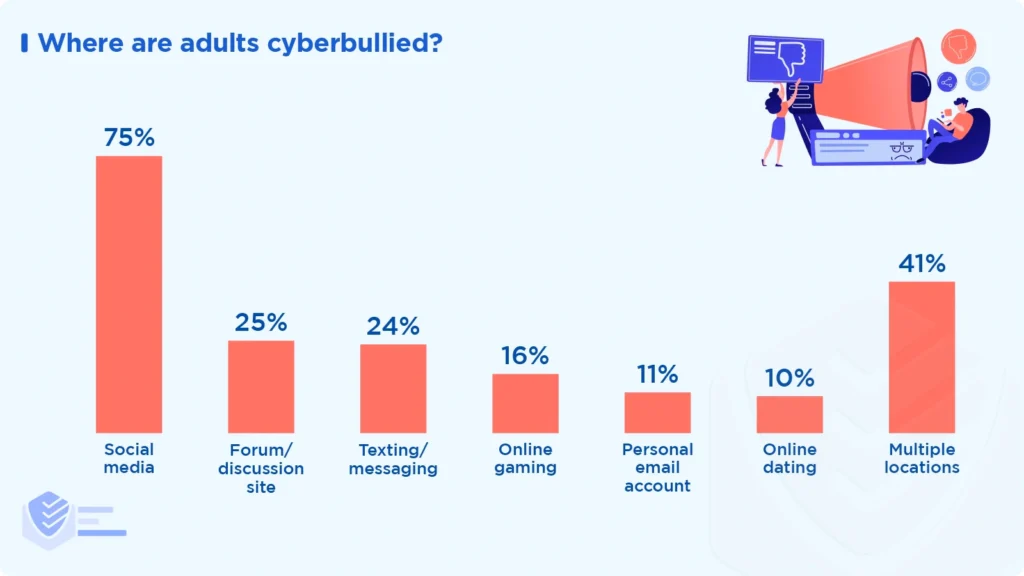
Legal and Reporting
- 21% of cyberbullying victims in the U.S. filed an official report with law enforcement in 2025.
- 32 states in the U.S. have updated or introduced new cyberbullying legislation in 2025.
- 18% of online bullying cases led to legal consequences such as restraining orders or fines in 2025.
- 12% of parents successfully pursued legal action after their child was harassed online in 2025.
- 55% of cyberbullying victims said they didn’t report incidents due to fear of escalation or retaliation in 2025.
- 42% of school-based cyberbullying reports were escalated to district-level intervention teams in 2025.
- 61% of college campuses now offer online reporting tools for cyberbullying and digital harassment as of 2025.
- 29% of social media users who reported abuse said no action was taken by the platform in 2025.
- 13% of cases reported to law enforcement were dropped due to insufficient evidence in 2025.
- 9% of teen victims who filed reports had to change schools due to a lack of resolution in 2025.
Prevention and Intervention Effectiveness Rates
- 46% of schools implementing anti-cyberbullying programs reported a measurable decline in incidents in 2025.
- 38% of students said awareness campaigns helped them recognize and report bullying behaviors in 2025.
- 29% of cyberbullying victims in 2025 benefited from psychological counseling provided through school programs.
- 22% of parental control software users reported a noticeable decrease in harmful online interactions in 2025.
- 35% of students said that peer-led anti-bullying initiatives felt more impactful than teacher-led ones in 2025.
- 41% of educators in 2025 received formal training in identifying and responding to cyberbullying.
- 27% of reported cyberbullying cases were resolved through mediation or restorative practices in 2025.
- 19% of teens involved in bullying behavior said school interventions helped them change their actions in 2025.
- 33% of middle schools used AI monitoring tools to flag harmful digital behavior in real time in 2025.
- 11% of victims felt interventions were ineffective or retraumatizing in 2025, highlighting areas for improvement.
Top Reasons Teens Are Being Cyberbullied
- 61% of teens report being cyberbullied because of their appearance, making it the most common trigger.
- 25% say their academic achievement was the reason for being targeted online.
- 17% were bullied due to their race, highlighting persistent racial bias in digital spaces.
- Both sexuality and financial status were cited by 15% of respondents as reasons for being bullied.
- 11% experienced cyberbullying because of their religion, reflecting the presence of intolerance online.
- 20% reported other reasons, showing that cyberbullying often stems from a wide range of personal attributes or circumstances.
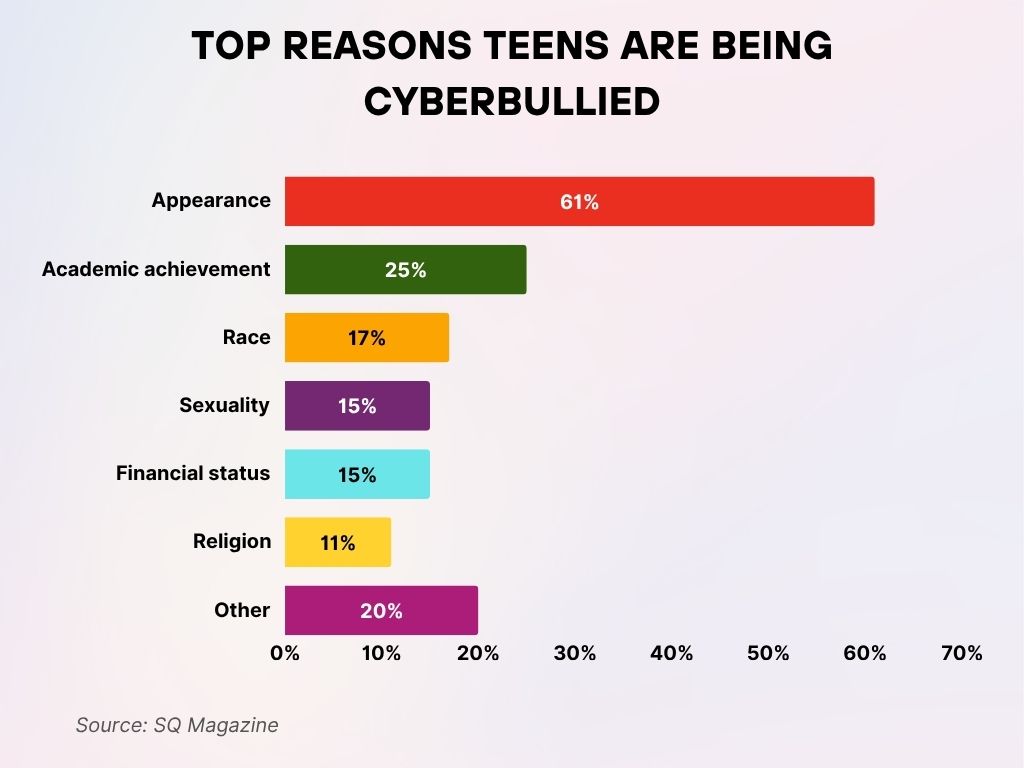
Regional and Country-Specific Comparisons
- In the United States, 36% of teens reported cyberbullying experiences in 2025, slightly higher than the global average.
- Canada reported a 39% victim rate among youth aged 10–18 in 2025, making it one of the highest among Western nations.
- In the United Kingdom, 31% of youth reported online harassment in 2025, with WhatsApp and TikTok being the most cited platforms.
- Australia saw a 26% rate of school-related digital bullying in 2025, largely tied to gaming and private group chats.
- In Germany, 18% of children aged 11–15 experienced impersonation-based bullying in 2025.
- India continued to face challenges, with 37% of surveyed teens experiencing cyberbullying in 2025, often through mobile messaging.
- Japan reported 15% of students experiencing sustained online harassment, with many cases going unreported in 2025.
- In Brazil, 41% of adolescents said they had either experienced or witnessed digital bullying in 2025, especially on social networks.
- South Africa reported a 23% rate of cyberbullying among teens in 2025, often linked to racial or socioeconomic discrimination.
- France saw 19% of secondary school students being involved in online gossip or rumor-spreading in 2025.
Online Harassment Among U.S. Internet Users
- 41% of U.S. internet users have experienced some form of online harassment, showing how widespread the issue is.
- 35% reported being targets of offensive name-calling, the most common type of harassment.
- 27% experienced severe harassment, reflecting the intensity of certain online attacks.
- 26% were victims of purposeful embarrassment, used as a tactic to shame or humiliate.
- 18% received physical threats through online platforms, revealing the real-world dangers of digital abuse.
- 13% have experienced stalking, a serious invasion of digital privacy and safety.
- Both sexual harassment and sustained harassment were reported by 12% of users, highlighting persistent forms of abuse.
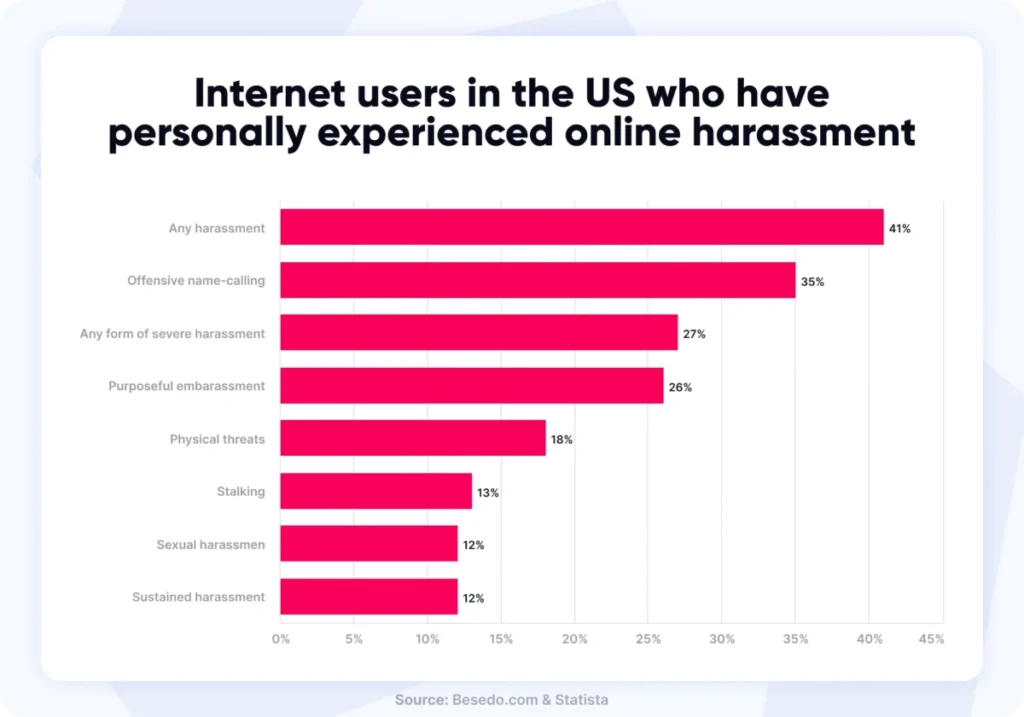
Recent Developments in Cyberbullying Trends
- AI moderation tools were adopted by 46% of major social platforms in 2025, with mixed user reviews on effectiveness.
- Snapchat introduced a Friend Check Reminder in 2025, prompting users to reconsider toxic digital relationships.
- TikTok reported removing 71 million+ videos globally in the first half of 2025 for community guideline violations, including harassment.
- Meta introduced automated warning nudges in Messenger and Instagram that decreased hate messages by 21% in 2025.
- Google’s Safe Browsing feature expanded to flag bullying-prone content in school-administered Chromebooks in 2025.
- Youth helpline calls related to cyberbullying rose by 14% in 2025, according to the International Youth Support Network.
- Discord rolled out AI-driven moderation bots that led to a 36% drop in cyberbullying complaints on large servers in 2025.
- Reddit launched a user-education portal on online civility in 2025, accessed by over 9 million users within three months.
- Parents’ groups on Facebook grew by 24% in 2025, many focused on online safety and digital behavior accountability.
- School districts in 15 U.S. states received federal funding in 2025 to deploy new tools that track digital harassment across devices.
Conclusion
Cyberbullying in 2025 is no longer confined to mean comments under a photo. It’s strategic, persistent, and can follow victims across multiple platforms and devices. But the tide is slowly turning, awareness is rising, legislation is evolving, and both technology and human support systems are stepping up.
As the data shows, prevention programs, legal reforms, and platform-level interventions are starting to show real impact. Still, there’s work ahead. Tackling this issue will require cooperation among schools, parents, tech companies, and policymakers. Only then can the online world reflect the respect, empathy, and safety we aim to nurture offline.































